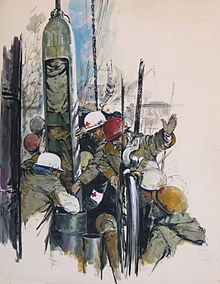Dahlbusch bomb


The Dahlbusch bomb (also Dahlbusch bomb or Dahlbusch rescue bomb ) is a 2.5 meter long and 38.5 centimeter wide, torpedo-shaped escape capsule that can be used in mining to rescue buried miners.
development
The steel capsule was developed in May 1955 within 5 days of an accident at the Dahlbusch colliery in Gelsenkirchen-Rotthausen . Its small diameter of 38.5 centimeters allowed it to be used as a rescue device from drilling diameters of 40 centimeters. The invention was a joint mining development at the Dahlbusch colliery. A patent was never applied for.
The Dahlbusch bomb got its name from the press based on its bomb-shaped shape and its first use at the Dahlbusch colliery.
Calls
Since their invention, the Dahlbusch bomb and similar rescue capsules have been used in various mine accidents:
- The Dahlbusch bomb was used for the first time at the Dahlbusch colliery. There, with their help, three miners, who were trapped by a collapsed blind shaft in a filling point between the tenth and eleventh levels , were cleared after five days - on May 12, 1955 - through a 42-meter-long vertical bore from the eleventh level upwards from 855 Meters depth saved.
- In a mine accident in the Gustav mine on November 13, 1957, two miners were also rescued with the Dahlbusch bomb after 121 hours.
- The Dahlbusch bomb gained further fame on November 7, 1963, when it was used to rescue eleven miners from the Mathilde iron ore mine after the Lengede disaster .
- After the mining accident in Lassing in 1998, a miner was pulled out with a capsule from a depth of 60 m after ten days.
- In 2002, nine miners were trapped underground at a depth of approximately 75 m after a massive water ingress in the Quecreek Mine , a coal mine in Lincoln Township , Somerset County , Pennsylvania, USA. After four days they were rescued by drilling a hole using an escape capsule, the design of which was derived from the Dahlbusch bomb.
- The Phoenix 2 rescue capsule used in the San José mine disaster in 2010 was 53 centimeters in diameter and was significantly more spacious than the Dahlbusch bombs with 38.5 centimeters in diameter.
literature
- Walter Bischoff, Heinz Bramann, Westfälische Berggewerkschaftskasse Bochum: The small mining dictionary . 7th edition. Glückauf Verlag, Essen 1988, ISBN 3-7739-0501-7 .
- Manfred Meier: The miracle of Lengede . 1st edition. Fischer-Taschenbuch-Verlag, Frankfurt am Main 2003, ISBN 3-596-16141-X .
Individual evidence
- ↑ Allgemeine Zeitung Bad Kreuznach from October 16, 2010
- ↑ The Dahlbusch bomb . In: Der Spiegel . No. 46 , 1963, pp. 33 ( Online - Nov. 13, 1963 ).
- ↑ cf. on the other hand, posting by Karlheinz Rabas in the forum of "Gelsenkirchen Stories" ; therefore Eberhard Au was not the inventor.
- ↑ Pit accident • Gustav pit. Accessed April 17, 2018 (German).
- ↑ Hannes Burger: The miracle of Lassing. Welt Online , July 28, 1998, accessed January 5, 2012 .
- ↑ Horst Rademacher: Rescue shafts: 58 meters in Lengede, 74 meters in Quecreek. FAZ.net , August 31, 2010, accessed January 5, 2012 .
Web links
- Dahlbusch bomb on the side of the German Mining Museum in Bochum
- The Dahlbusch bomb . In: Der Spiegel . No. 46 , 1963, pp. 33 ( Online - Nov. 13, 1963 ).
- General newspaper Bad Kreuznach from October 16, 2010
